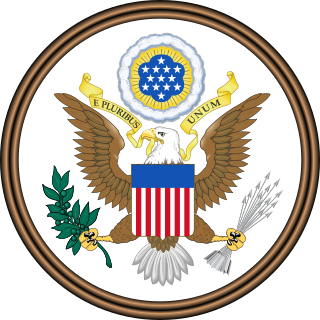
The Emergency Quota Act, also known as the Emergency Immigration Act of 1921, the Immigration Restriction Act of 1921, the Per Centum Law, and the Johnson Quota Act, was formulated mainly in response to the large influx of Southern and Eastern Europeans and restricted their immigration to the United States. Although intended as temporary legislation, it "proved, in the long run, the most important turning-point in American immigration policy" because it added two new features to American immigration law: numerical limits on immigration and the use of a quota system for establishing those limits, which came to be known as the National Origins Formula.
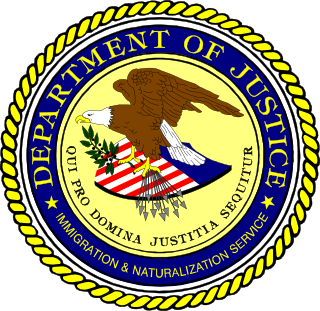
The United States Immigration and Naturalization Service (INS) was an agency of the U.S. Department of Labor from 1933 to 1940 and the U.S. Department of Justice from 1940 to 2003.

Border control comprises measures taken by governments to monitor and regulate the movement of people, animals, and goods across land, air, and maritime borders. While border control is typically associated with international borders, it also encompasses controls imposed on internal borders within a single state.

United States Customs and Border Protection (CBP) is the largest federal law enforcement agency of the United States Department of Homeland Security. It is the country's primary border control organization, charged with regulating and facilitating international trade, collecting import duties, as well as enforcing U.S. regulations, including trade, customs and immigration. CBP is one of the largest law enforcement agencies in the United States. It has a workforce of more than 45,600 federal agents and officers. It is headquartered in Washington, D.C.

The Immigration Act of 1924, or Johnson–Reed Act, including the Asian Exclusion Act and National Origins Act, was a federal law that prevented immigration from Asia and set quotas on the number of immigrants from Eastern and Southern Europe. It also authorized the creation of the country's first formal border control service, the U.S. Border Patrol, and established a "consular control system" that allowed entry only to those who first obtained a visa from a U.S. consulate abroad.

United States border preclearance is the United States Department of Homeland Security's (DHS) practice of operating prescreening border control facilities at airports and other ports of departure located outside of the United States pursuant to agreements between the United States and host countries. Travelers are subject to immigration and customs inspections by Customs and Border Protection (CBP) officers before boarding their transportation onward to the United States. Preclearance applies to all passengers regardless of their nationality or purpose of travel. Upon arrival, precleared passengers arrive in the United States as domestic travelers, but may still be subject to re-inspection at the discretion of CBP. This process is intended to streamline border procedures, reduce congestion at American ports of entry, and facilitate travel into airports that otherwise lack immigration and customs processing facilities for commercial flights.

The Immigration Act of 1917 was a United States Act that aimed to restrict immigration by imposing literacy tests on immigrants, creating new categories of inadmissible persons, and barring immigration from the Asia-Pacific zone. The most sweeping immigration act the United States had passed until that time, it followed the Chinese Exclusion Act of 1882 in marking a turn toward nativism. The 1917 act governed immigration policy until it was amended by the Immigration Act of 1924; both acts were revised by the Immigration and Nationality Act of 1952.
Asian immigration to the United States refers to immigration to the United States from part of the continent of Asia, which includes East Asia, South Asia, and Southeast Asia. Asian-origin populations have historically been in the territory that would eventually become the United States since the 16th century. The first major wave of Asian immigration occurred in the late 19th century, primarily in Hawaii and the West Coast. Asian Americans experienced exclusion, and limitations to immigration, by the United States law between 1875 and 1965, and were largely prohibited from naturalization until the 1940s. Since the elimination of Asian exclusion laws and the reform of the immigration system in the Immigration and Nationality Act of 1965, there has been a large increase in the number of immigrants to the United States from Asia.

The Immigration Restriction League was an American nativist and anti-immigration organization founded by Charles Warren, Robert DeCourcy Ward, and Prescott F. Hall in 1894. According to Erika Lee, in 1894 the old stock Yankee upper-class founders of the League were, "convinced that Anglo-Saxon traditions, peoples, and culture were being drowned in a flood of racially inferior foreigners from Southern and Eastern Europe." Established during a period of increasing anti-immigration sentiment in the United States, the League was founded by Boston Brahmins such as Henry Cabot Lodge with the purpose of preventing immigrants from southern and eastern Europe from immigrating to the U.S. due to a belief that they were racially inferior to western and northern Europeans. The League argued that the American way of life was threatened by immigration from these regions, and lobbied Washington to pass anti-immigration legislation restricting the entry of what they perceived as "undesirable" immigrants in order to uphold Old Stock Americans hegemony.
According to the 2021 Canadian census, immigrants in Canada number 8.3 million persons and make up approximately 23 percent of Canada's total population. This represents the eighth-largest immigrant population in the world, while the proportion represents one of the highest ratios for industrialized Western countries.
Canadian immigration and refugee law concerns the area of law related to the admission of foreign nationals into Canada, their rights and responsibilities once admitted, and the conditions of their removal. The primary law on these matters is in the Immigration and Refugee Protection Act, whose goals include economic growth, family reunification, and compliance with humanitarian treaties.
Operation Gatekeeper was a measure implemented during the presidency of Bill Clinton by the United States Border Patrol, aimed at halting illegal immigration to the United States at the United States–Mexico border near San Diego, California. According to the INS, the goal of Gatekeeper was "to restore integrity and safety to the nation's busiest border."

The history of immigration to the United States details the movement of people to the United States from the colonial era to the present. Throughout U.S. history, the country experienced successive waves of immigration, particularly from Europe and later on from Asia and Latin America. Colonial-era immigrants often repaid the cost of transoceanic transportation by becoming indentured servants in which the new employer paid the ship's captain. In the late 19th century, immigration became restricted from China and Japan. In the 1920s, restrictive immigration quotas were imposed although political refugees had special status. Numerical restrictions ended in 1965. In recent years, the largest numbers have come from Asia and Central America.
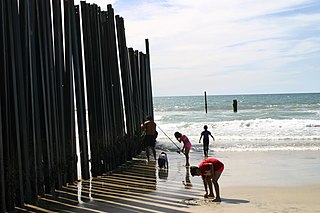
Illegal entry is the act of foreign nationals arriving in or crossing the borders into a country in violation of its immigration law. Human smuggling is the practice of aiding people in crossing international borders for financial gain, often in large groups. Human smuggling is associated with human trafficking. A human smuggler will facilitate illegal entry into a country for a fee, but on arrival at their destination, the smuggled person is usually free. Trafficking involves physical force, fraud, or deception to obtain and transport people, usually for enslavement or forced prostitution.

The padrone system was a contract labor system utilized by many immigrant groups to find employment in the United States, most notably Italian, but also Greeks, Chinese, Japanese, and Mexican Americans. The word 'padrone' is an Italian word meaning 'boss', 'manager' or 'owner' when translated into English. The system was a complex network of business relationships formed to meet a growing need for skilled and unskilled workers. Padrones were labor brokers, usually immigrants or first-generation Americans themselves, who acted as middlemen between immigrant workers and employers.
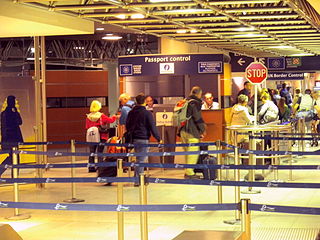
Juxtaposed controls are a reciprocal arrangement between Belgium, France, the Netherlands and the United Kingdom whereby border controls on certain cross-Channel routes take place before boarding the train or ferry, rather than upon arrival after disembarkation. With the exception of the Eurotunnel Shuttle route, customs checks remain unaffected by juxtaposed immigration controls and continue to take place upon arrival after disembarkation. Belgium, France and the Netherlands are all member states of the European Union and part of the border-free Schengen Area. The United Kingdom, on the other hand, has never participated in the Schengen Area, even when it was a member state of the European Union. As a result, juxtaposed controls aim to increase the convenience and efficiency of border checks when travelling by train or ferry between the Schengen Area and the UK by removing the need for immigration checks on arrival and by streamlining checks on departure. At the same time, juxtaposed controls are intended to detect and prevent illegal immigration. In 2016, there were over 56,000 instances when people were refused entry to the UK at the juxtaposed controls.

The Washington Avenue Immigration Station was an immigrant processing facility in Philadelphia, Pennsylvania, United States located at the end of Washington Avenue at Pier 53 on the Delaware River, south of modern-day Penn's Landing waterfront district. The building opened in 1873 and was demolished in 1915.

The Immigration Act of 1891, also known as the 1891 Immigration Act, was a modification of the Immigration Act of 1882, focusing on immigration rules and enforcement mechanisms for foreigners arriving from countries other than China. It was the second major federal legislation related to the mechanisms and authority of immigration enforcement, the first being the Immigration Act of 1882. The law was passed on March 3, 1891, at the end of the term of the 51st United States Congress, and signed into law by then United States President Benjamin Harrison.
Immigrant surveillance refers to the practice of tracking both illegal and legal immigrants through several methods, some of which include electronic verification, border surveillance, or federal raids. Historically, countries such as the United States have required that immigrants carry evidence of citizenship. Controversies within immigrant surveillance in the United States involve the alleged racial profiling committed by police departments and negligence found in detention centers. Laws concerning surveillance and immigration vary by country but terrorist attacks have made the issue more prevalent.
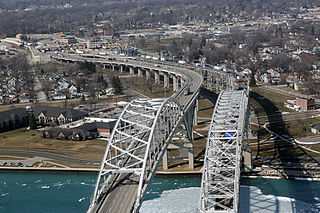
The Port Huron–Sarnia Border Crossing connects the cities of Port Huron, Michigan and Sarnia, Ontario. It is located at the Blue Water Bridge at the St. Clair River.